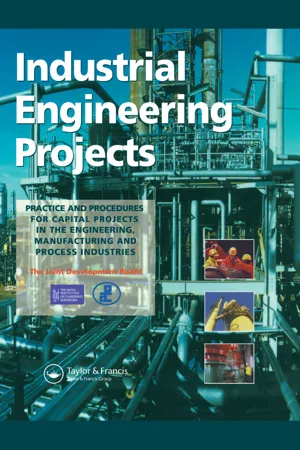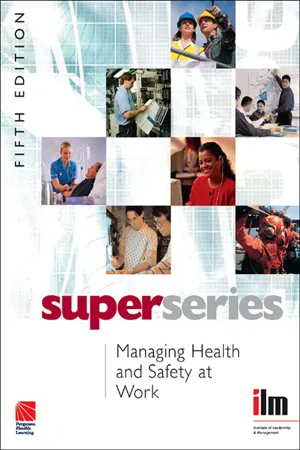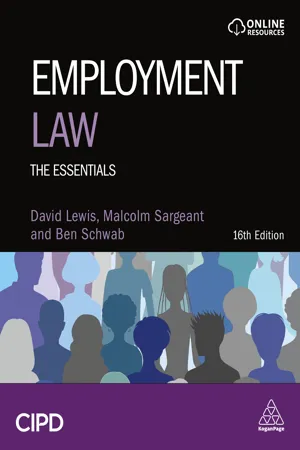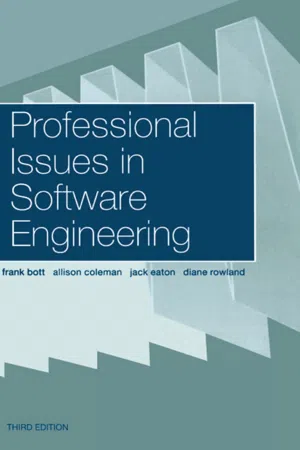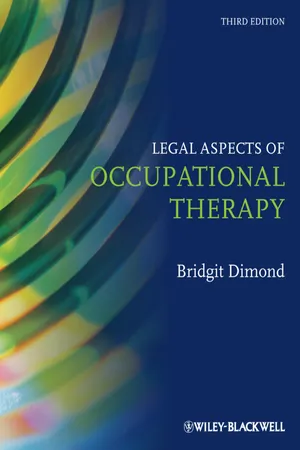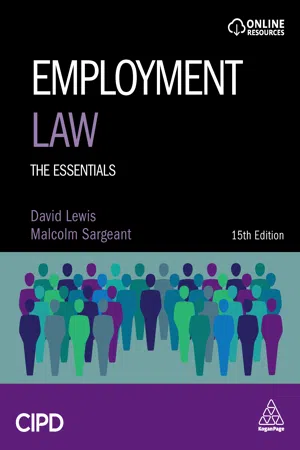Technology & Engineering
Health & Safety at Work Act 1974
The Health and Safety at Work Act 1974 is a key piece of legislation in the UK that outlines the responsibilities of employers to ensure the health, safety, and welfare of their employees at work. It also places duties on employees to take reasonable care of their own health and safety, as well as that of others who may be affected by their actions at work. The Act provides a framework for managing workplace health and safety.
Written by Perlego with AI-assistance
Related key terms
1 of 5
10 Key excerpts on "Health & Safety at Work Act 1974"
- eBook - PDF
- Mike Tooley, Lloyd Dingle(Authors)
- 2010(Publication Date)
- Routledge(Publisher)
Although these premises are not directly within the remit of the HSE, they may have some enforcement responsibilities over and above that of the local authority and a system of flexible warrants was introduced in 2006 to account for this fact. The Health and Safety at Work Act Introduction The Health and Safety at Work Act (1974) is the major piece of legislation upon which all workplace health and safety regulations are based. It differs fundamentally in principle from any previous health and safety legislation. The underlying reasoning behind the Act was the need to foster a much greater awareness of the problems that surround health and safety matters and, in particular, a much greater involvement of those who are, or who should be, concerned with improvements in occupational health and safety. Consequently, the Act seeks to promote greater personal involvement coupled with the emphasis on individual responsibility and accountability. Health and Safety in the Engineering Workplace 7 UNIT 1 You need to be aware that the Health and Safety at Work Act applies to people, not to premises. The Act covers all employees in all employment situations. The precise nature of the work is not relevant from the point of view of the Act, neither is its location. However, in this unit we will be concentrating on the hazards and risks associated with some of the more specific engineering activities that take place in the engineering workplace. The Act also requires employers to take account of the fact that other persons, not just those that are directly employed, may be affected by work activities. The Act also places certain obligations on those who manufacture, design, import or supply articles or materials for use at work to ensure that these can be used in safety and do not constitute a risk to health. - eBook - PDF
Industrial Engineering Projects
Practice and procedures for capital projects in the engineering, manufacturing and process industries
- Association of Cost Engineers and the Royal Institute of Cha(Author)
- 2014(Publication Date)
- CRC Press(Publisher)
12.3 THE HEALTH AND SAFETY AT WORK ACT 1974 Most of the Health and Safety at Work Act 1974 came into force on I April 1975. It created a new approach to safety law by saying what should be done in the best interests of safety for people at work, setting goals to be met rather than being prescriptive, as previous legislation. The Act took up the theme ofthe Robens Report with a view to 'making safety everybody's busi-ness' and extended the responsibilities to visitors to the workplace, including contractors, subcontractors and any other person who might have cause to be in or near the workplace, including the safety ofthe general public. Many people still think about the effects of accidents in terms of insur-ance and how much compensation might become due. The Health and Safety at Work Act is mainly concerned with those who create the risk con-trolling the risks. Those who do not are liable under the Act for prosecution, the penalties for not complying ranging from heavy fines to prison sentences. The Act created a body -The Health and Safety Commission (HSC) -to become responsible for the development of health and safety legislation and its application at policy level. It also created the Health and Safety Executive (HSE) to be responsible for the implementation and administra-tion of most matters concerning safety and the law. 12.3.1 Scope of the Act The Health and Safety at Work Act is of overriding importance in almost all work situations today and its provisions should be considered before going on to the specific requirements of any other Acts and Regulations which may be applicable. The Act provides such wide protection that it not only requires employers to have regard to the health and safety of their own workforce but also requires protection for members of the general public who may be endangered in some way by the activities of the employer. - eBook - ePub
- Nikki Booth, Clare Robson, Jacqui Welham, Alison Barnard, Nicki Bartlett(Authors)
- 2009(Publication Date)
- Routledge(Publisher)
Health and Safety at Work, etc Act 1974 (HSWA 1974) provided legal protection to all workplaces. Exposure of vulnerable people to workplace hazards can be identified throughout history and even today there are those who are exposed to risks to their health and safety, albeit in different circumstances to earlier years.3.2 The Health and Safety at Work, etc Act 1974
The HSWA1974 emanated from a committee of six, chaired by Lord Robens. He was chairman of the National Coal Board, a post he held from 1961 until 1972. During that time he had taken to writing personal letters to the widows and mothers of those killed in the pits. During his time deaths at work reduced in number, but he considered that there were still too many accidents. This first hand knowledge and experience provided him with the credentials he needed to chair the committee.The committee determined that there was a need to move away from prescriptive legislation to adopt a self-regulating system, which focused on the need to have better systems of safety organisation, management initiatives and more involvement of the workforce. The emphasis was that with health and safety, good management should be normal management, and that effective management will encompass detailed policy and objectives within an effective organisation. The HSWA 1974 provides the UK with a framework of legislation placing a duty on employers, the self-employed and employees to conduct their activities in such a way that those who could be affected by the activity of the business are not harmed. This extends to those who are not connected with the activities, such as members of the public. The HSWA 1974 - eBook - PDF
- Cooper(Author)
- 2012(Publication Date)
- Academic Press(Publisher)
8 Health and Safety Salus populi suprema rex. The greatest law is the people's safety. (Adapted from Justinian's Twelve Tables of Roman Law) Since the advent of the Health and Safety at Work etc. Act 1974 (HSWA) health and safety have become a vital factor in all aspects of the work place. An understanding of the Act's implications is essential to employers, employees and others. It gives rise to regulations, guidelines and codes made under the Act itself and also requires employers to produce policy statements and local codes of practice or rules appropriate to particular premises. In addition, there has been a trend for national organisations to produce codes or guidelines for consideration or adoption by their constituent members. Occupational health and safety has become a discipline in its own right and a large employer will normally appoint full-time safety officers. In addition, the Safety Representatives and Safety Committees Regulations 1977 require an employer to set up a safety committee if requested to do so by a recognised trade union and to consult safety representatives appointed by the union. HEALTH AND SAFETY AT WORK ETC. ACT 1974 The HSWA applies to all persons at work, which includes employers, employees, the self-employed, any persons on the work premises who are not employees and any members of the general public who may be affected by activities involved in work. The category of non-employees extends to those such as tradesmen or social visitors, contractors' employees, research workers supported by an outside grant, students, visiting staff, guest speakers or voluntary workers. The purpose of the Act is to secure the health, safety and welfare of persons at work and to protect others from risks to health and safety resulting from the activities of those at work (s. 1). It is also the purpose of the Act to provide controls over dangerous materials and over the emission of obnoxious or offensive substances. - eBook - ePub
- Institute of Leadership & Management(Author)
- 2013(Publication Date)
- Routledge(Publisher)
Until the mid twentieth century, the health and safety of people at work continued to be poorly protected. Legislation was piecemeal, often following specific abuses or disasters.1.1 The Health & Safety At Work, etc. Act 1974
The major turning point came in 1974, with the first comprehensive Health & Safety at Work, etc. Act (HSWA), which imposed a general duty of care on virtually every employer.The Act imposes clear duties on employers relating to health, safety and welfare at work, and also provides guidance on how to promote high standards in these areas. It also imposes obligations on employees to take care for themselves and others who may be affected by their actions.The opening sentence of the Act includes the word ‘welfare’:‘An Act to make further provision for securing the health, safety and welfare of persons at work...’and it is important to keep this third aspect of the Act in mind when you are looking at health and safety issues at your workplace. But we begin with a preface to our subject.2 Introduction to health and safety legislation
We need to start by seeing health and safety in the context of the law in general.2.1 Sources of law
The law applicable in the UK is derived from three principal sources:Although Scottish law has continued to develop along different lines from English law since the Act of Union in 1703, and is partly derived from Scottish common law, all the Acts and regulations we will discuss in this workbook are also applicable in Scotland.statute lawActs of parliament, such as the Health and Safety at Work, etc. Act 1974, together with subordinate legislation (sometimes called ‘statutory instruments’), such as the Management of Health and Safety at Work Regulations 1999.common lawbased on case law – the decisions made in courts over the centuries. Once a judgment is made, a precedent is established. A court is bound to follow earlier decisions made in higher courts, or in courts at the same level.contract lawgoverning agreements between two parties. Contract law does not play much part in health and safety. - Anne Galbraith, Michael Stockdale, Steve Wilson, Simon Spurgeon, Mick Woodley, Alan Davenport, Carrie de Silva, Jennifer Charlson, Carrie de Silva, Jennifer Charlson(Authors)
- 2020(Publication Date)
- Routledge(Publisher)
The number of fatal injuries to workers reported in 2018–19 (147) was slightly higher than the previous year, but there is a continuing a trend that has seen fatalities at work reduced to a level which is less than one-third of that recorded in the 1980s. On the other hand, there is little room for complacency as the number of reported major injuries to employees has only decreased marginally in recent years. And fatalities are, of course and thankfully, a tiny proportion of the issue. Many millions of days are lost each year due to work-related injury and ill health. In part the improvement in fatal and non-fatal injuries is attributable to shifts from manufacturing and heavy industries to service sectors, where risks are generally lower.Dissatisfaction with the existing system of piecemeal legislation led to a review by the Robens Committee on Safety and Health at Work (1972). Robens recommended a major revision of the approach to health and safety with a move away from legislation which applied to specific types of workplace to a single Act which would provide comprehensive coverage to workplaces in general. It also stated that the promotion of safety and health at work was the joint responsibility of both management and employees. The implementation of this new thinking on health and safety took the shape of the Health and Safety at Work etc. Act (HSWA) 1974. This was a piece of framework legislation which established certain general duties on employers, workers and others, introduced new requirements for safety representatives and committees, and amended the existing regulatory and enforcement machinery with the establishment of the Health and Safety Commission and the Health and Safety Executive. It was never intended that the existing legislation be substituted overnight, rather the aim was that over time the Acts which related to specific places of work would be replaced by regulations and codes of practice of more general application. However, although some important changes were made, overall progress on this process of substitution proved to be slower than anticipated and towards the end of the 1980s much of the old legislation was still in place. But new impetus was brought to the process of reform in the shape of the Single European Act of 1987, which introduced Article 118A, thereby enabling improvements to the work environment and to health and safety to be adopted by qualified majority voting rather than by the unanimous assent of member states. Since that time a programme of safety, hygiene and health reforms has been put in place and, starting with the European Framework Directive in 1989, a series of directives has been passed which has had a profound effect on the working environment in the UK and across Europe. With the leaving of the EU, any relevant provisions not already in UK legislation are adopted through Health and Safety (Amendment) (EU Exit) Regulations 2018.- eBook - ePub
Employment Law
The Essentials
- David Lewis, Malcolm Sargeant, Ben Schwab(Authors)
- 2023(Publication Date)
- CIPD - Kogan Page(Publisher)
09Health and safety at work
Chapter overview
This chapter outlines UK laws relating to occupational health and safety. It distinguishes between the systems for injury prevention and injury compensation, noting the respective roles of civil and criminal law, common law and statute. The Health and Safety at Work Act 1974 (HASAWA 1974) is explained, together with the role of the Health and Safety Executive (HSE). The broad general duties set out in the Act are introduced, especially those imposed on employers to ensure the health, safety and welfare of their employees while at work and not to put others at risk by their activities. The Management of Health and Safety at Work Regulations 1999 are outlined, and there is a brief description of some of the more important of the other Regulations made under the 1974 Act.LEARNING OUTCOMES After studying this chapter you will have a basic understanding of:- the legal principles contained in both HASAWA 1974 and the regulation-making powers in this Act1
- the legal obligations of duty holders under HASAWA 1974
- the duty to undertake and respond to risk assessments
- the value of working with safety representatives
- the role of the health and safety inspectors
- when it is necessary to obtain expert advice.
9.1 Injury prevention and injury compensation
The primary purpose of the law should be to make work safe so that it does not cause personal injury – but provision also has to be made for the financial support of people who nevertheless suffer injury. ‘Injury’ covers both physical and mental impairment caused by accident or illness. In the UK, the social security system provides income maintenance for those who by reason of sickness, injury or disability are unable to work. In addition, victims may sue in the civil courts for damages (see Chapter 3 , section 3.1.4 ); this aspect of the general law of tort2 has been developed largely through judges deciding the claims of the litigants. Those who sue in respect of work-related injury will claim that the defendant has caused the injury.3 The Employers’ Liability Act 1969 requires employers to have insurance cover to meet damages awarded to employees, for bodily injury but it may not cover harassment as this does not normally lead to physical, as opposed to mental suffering. No insurance is required to cover public liability (liability to those who are not employees, eg a member of the public), but employers will be unwise not to have such cover and also cover for harassment since even innocent employers may be vicariously liable for acts of harassment committed by their employees.4 - eBook - PDF
- Frank Bott, Allison Coleman, Allison Coleman, Diane Rowland(Authors)
- 2000(Publication Date)
- CRC Press(Publisher)
As has already been pointed out, the Act is intended to encourage perso-nal responsibility and to make individuals, as well as corporate bodies, accountable for their acts or omissions which result in contravention of the law. Thus it is not only companies who may be prosecuted for offences relating to their premises or to their status as designers or manufacturers. Individuals such as directors, managers, or indeed any employee, including software engineers may be held responsible for breaches in the law. This may lead to prosecution; in serious cases the fines are unlimited and impri-sonment is a possibility. In addition, where personal liability is proved, there may be other sanctions available such as disqualification as a director under the Companies Acts. If this sounds alarmist, it is as well to remember that the objective is not punishment but the encouragement of all to take personal responsibility, as far as is within their power, to promote healthy and safe working conditions, and to safeguard others who may be put at risk by their activities. 9.4.9 Health and Safety Commission and Health and Safety Executive The Robens Committee recommended the creation of a national authority for health and safety at work. This was reflected in the Health and Safety at Work Act by the establishment of the Health and Safety Commission (HSC) and the Health and Safety Executive (HSE), responsible to the Secretary of State for Employment. 250 Professional issues in software engineering The Health and Safety Commission The HSC consists of a chairman and between six and nine other members appointed by the Secretary of State. These are drawn from the trade unions, employers organizations, and other relevant organizations such as local authorities and professional bodies. Among the Commission’s primary func-tion is the making of arrangements to secure the health, safety, and welfare of people at work and to protect the public from risks that may arise from work activities. - eBook - ePub
- Bridgit C. Dimond(Author)
- 2011(Publication Date)
- Wiley-Blackwell(Publisher)
11 Health and SafetyThe occupational therapist (OT) works in a potentially dangerous environment, whether in a domestic setting or in hospital therapy centres and workshops. This chapter covers the basic principles of law relating to health and safety at work, both statutory provisions and common law duties, taking examples from occupational therapy practice. The following topics are covered:Laws relating to medical devices and the Consumer Protection Act 1987 are considered in Chapter 15 on equipment and those relating to transport in Chapter 16. The Health and Safety at Work etc. Act 1974 (HASAW)- The Health and Safety at Work etc. (HASAW) 1974
- Regulations under HASAW
- The Management of Health and Safety at Work Regulations 1999
- Risk Management and the OT
- Manual Handling Regulations
- Reporting of Injuries, Diseases and Dangerous Occurrences Regulations 1995
- National Patient Safety Agency
- The Occupiers’ Liability Act 1957
- The Occupiers’ Liability Act 1984
- Control of Substances Hazardous to Health Regulations (COSHH) 1988
- The Employers’ Liability (Defective Equipment) Act 1969
- Employers’ Liability (Compulsory Insurance) Act 1969
- Common law duty implied in the contract of employment
- Special areas: cross-infection, animals, violence, stress and bullying, sexual harassment
- Staff health
The Health and Safety at Work etc. Act 1974 (HASAW) is enforced through the criminal courts by the Health and Safety Executive (HSE) and its Inspectorate, which has the power to prosecute for offences under the Act and the Regulations, and which also has powers of inspection and can issue enforcement or prohibition notices. Since the abolition of the Crown’s immunity in relation to the health and safety laws (by the National Health Service (Amendment) Act 1986) prosecutions and notices can be brought against health authorities. Trusts do not enjoy any immunity from prosecution under health and safety legislation. Social services departments can also be prosecuted. - eBook - ePub
Employment Law
The Essentials
- David Lewis, Malcolm Sargeant(Authors)
- 2019(Publication Date)
- CIPD - Kogan Page(Publisher)
All employers have an obligation to conduct risk assessments. The purpose of this assessment is to identify the measures that must be taken to ensure compliance with the statutory provisions contained in HASAWA 1974, and relevant regulations, taking into account any ACOP or guidance issued by the HSE.- Employers are required not only to carry out but also respond to risk assessments; such assessments should include consideration of stress-related injury.
- COSHH requires employers to prevent or adequately control the exposure of their employees to, and others who may be affected by, hazardous substances.
- There is a duty on employers to provide information to and consult with employees either directly or through their representatives who are either trade-union-appointed or directly elected.
Notes
1 This chapter contains extracts from or close paraphrasing of legislation which is on the opsi.gov.uk website and is subject to crown copyright. The reproduction of this material here is licensed under the open government licence v1.0.2 Most occupational health and safety regulations are made under section 15 of HASAWA 1974 and known as ‘relevant statutory instruments’, although some which represent the implementation of European Directives were made under other legislation and the HSE has been empowered to enforce them too – for example, the Supply of Machinery (Safety) Regulations 2008, SI 2008 No 1597 and the Working Time Regulations 1998, SI 1998 No 833 were made under section 2(2) of the European Communities Act 1972. The Working Time Regulations are covered in Chapter 10 .3
Index pages curate the most relevant extracts from our library of academic textbooks. They’ve been created using an in-house natural language model (NLM), each adding context and meaning to key research topics.

